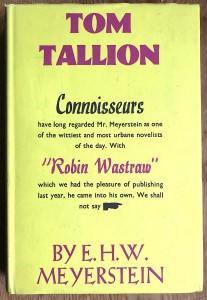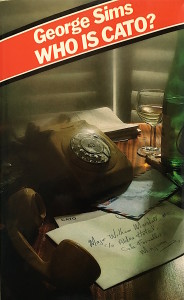 Found among a collection of publisher’s file copies from the Gollancz archive a novel by E.H.W. Meyerstein. It was his last work, as he died in the year of its publication (1952). It was a bibliomystery set in Hampstead entitled Tom Tallion. The blurb and printed notes on the sleeves of thejacket are lengthy and enthusiastic and its anonymous author had probably read the whole book and may have even been a fan of Meyerstein’s work.
Found among a collection of publisher’s file copies from the Gollancz archive a novel by E.H.W. Meyerstein. It was his last work, as he died in the year of its publication (1952). It was a bibliomystery set in Hampstead entitled Tom Tallion. The blurb and printed notes on the sleeves of thejacket are lengthy and enthusiastic and its anonymous author had probably read the whole book and may have even been a fan of Meyerstein’s work.
Connoisseurs have long regarded Mr Meyerstein as one of the wittiest and most urbane novelists of the day… This book has the same delightful blend of the prosaic and the fantastic [as his last novel Robin Wastraw]. Mr Meyerstein writes of the most startling events as if they were commonplaces, and through his eyes the ordinary business of living takes on a fabulous quality.
It would be a pity to describe the plot, though we could hardly spoil the reader’s pleasure by doing so. Tom, like Robin, is a reflective boy brought up in a scholarly and eccentric environment, haunted by echoes of murder and arson, pursued by a middle-aged woman, remaining detached from all such extravagances of behaviour and quietly following his own interests and calling. There are exquisite episodes. There’s the day, for instance, when Tom, bored with ‘nature study’ at school, eats the pomegranate which he is supposed to be drawing, then sketches it from memory with a sudden assurance – he thereby discovers a unique theory of art, and painting becomes his vocation. There is the business of old Mr Wilkins sudden death. There was Captain Clements, who erupts into Tom’s life with his sinister interest in the occult. There is Mrs Heene, the missionary author of God or Dog? who abruptly loses her faith and raise a flag with the inscription: “THERE IS NO GOD (MRS) HIRAM HEENE.’

 Found in a thriller by
Found in a thriller by 
